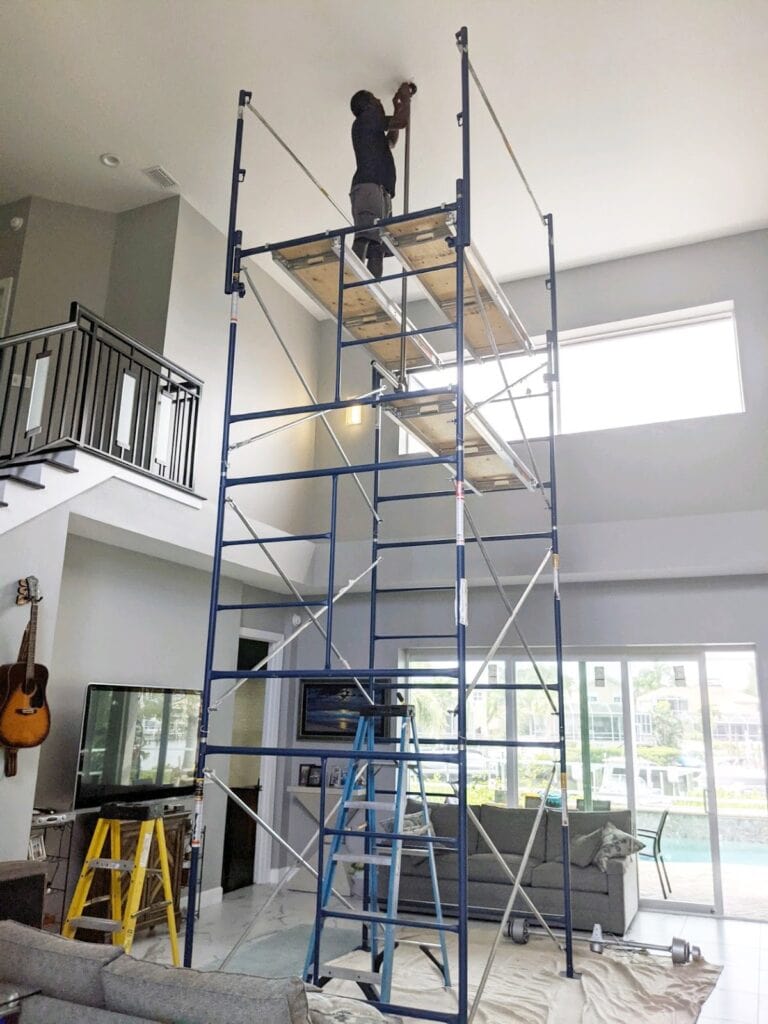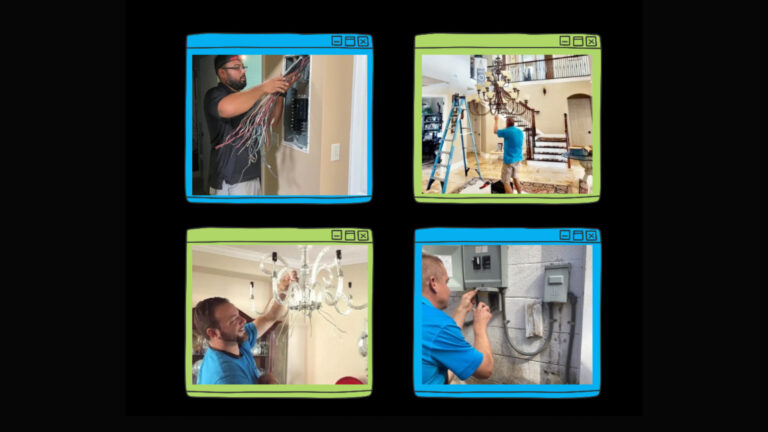When people call us wanting an electrical job done, one of the first questions is almost always: “Why does one job cost a few hundred dollars, and another several thousand?”
The short answer is: lots of moving parts.
Below, we’ll break down what really drives electrical project costs so you have clearer expectations and can see what makes your quote high, low, or somewhere in between.
1. Project Type & Scope
Some jobs are pretty simple, such as swapping a light fixture, replacing a ceiling fan, or installing a smoke detector; others are massive upgrades: entire panels, EV charger circuits, spa wiring, etc. The bigger the job, the more materials, time, permits, and labor involved.
Here’s an example from our electrical project pricing guide:
- Ceiling Fan Replacement starts at about $185 for labor, more if ceilings are high, wiring needs replacing, or heavy-duty fixtures are used
- Spa Wiring begins around $2,800+ due to distances, power requirements, wiring upgrades, etc.
So one big cost-driver is how complex the job is — size, power needs, location, wiring distance, obstacles, etc.
You may also be interested in: What Really Drives the Cost of a Generator Bypass System for Your Home
2. Materials & Equipment

All electrical work needs materials: wire, breakers, panels, conduits, connectors, weatherproofing, and specialty components (like surge protectors or high‑amp charger components). If you want high-end, weather- or fire‑rated, code‑approved hardware, that adds cost.
For example:
- Upgrading a panel from 150A to 400A means much heavier wiring, a larger panel, possibly bigger gauge service entry wires, etc.
- For EV chargers: whether it’s hardwired vs plug‑in, requiring trenching/conduit, the amperage level—all those material choices and installation requirements can swing cost significantly.
3. Labor & Skilled Work
Working with electricity is specialized. You need trained electricians who understand codes, safety, wiring rules, inspections. Labor is expensive — especially if you use licensed, experienced technicians. Also:
- Troubleshooting unknown issues takes time. Some repair jobs are unpredictable; what seems simple may hide complex wiring, damage, or code violations.
- Difficult access (tight spaces, high ceilings, walls that require demo) adds labor time.
4. Code, Permits, and Inspection Requirements
Electrical work isn’t just about running wire and screwing in fixtures. Cities/counties have regulations. Permits cost money; inspections take time; codes change, and staying up to code is non-negotiable.
From your site:
- All major electrical work is permitted and inspected.
- Things like GFCI or AFCI protection across circuits, or upgrading panels, may be required by code and force you to pay more.
5. Accessibility & Location Challenges

If the job is easy to reach—panel is accessible, wiring runs are short, walls are open—costs are lower. But if there’s drywall to remove, long runs through finished spaces, high ceilings, or weather‑protected outdoor work, cost rises.
Some cost‑raisers listed:
- Long conduit runs from panel to location (e.g. generator hookup)
- Recessed or hard‑to‑access panels
6. Time, Scheduling & After‑Hours
Projects scheduled under normal business hours are cheaper than work done nights, weekends, or with urgent/emergency demand. Also, if you want the job done quickly, sometimes that means paying a premium.
7. Company Overhead, Experience, & Warranty
Not all electricians are equal. What you pay includes:
- Employee training, certification, insurance
- Quality assurance, warranty/guarantee (on installations, materials)
- Mark‑ups on materials to cover handling, delivery, liability, manufacturer warranties
- Reputation, reliability, and guarantees—lower cost sometimes comes with cutting corners (no permits, no warranty, cheaper materials)
8. Market & External Factors
Sometimes, even small jobs cost more because external market forces are working. Things like material price hikes (copper, steel, electronics), labor shortages, fuel/transportation costs, supply chain delays, and changing regulations all feed into higher baseline costs. Your quote reflects not just your job, but what everyone is paying.
9. What Lowers the Cost
To balance all that, there are things that help reduce cost; not everything is always expensive. Some ways to save include:
- Having parts of the work done previously or using existing wiring/circuits rather than full rewiring.
- Keeping panel upgrades minimal. If your current panel is already adequate, upgrades cost less.
- Job access being easy, with short runs, minimal wall removal, etc.
- Bundling multiple smaller tasks at once (so setup, travel, overhead costs are amortized across more work).
10. Why Two Quotes Can Look Very Different
Because so many variables are in play, two electricians quoting the same type of job can come up with very different numbers. Maybe one includes premium materials, full warranty, consistent code compliance, high labor rates. The other might do it more cheaply, but with trade‑offs: less experienced labor, non‑premium materials, minimal permitting, fewer safety features, perhaps less robust warranty.
What “Small Jobs” vs “Large Projects” Typically Cost
Here are some ranges for context:
Takeaways — What You Should Ask/Know Before Getting a Quote
To make sure you’re comparing apples to apples (and avoid surprises), when getting quotes, you should ask:
- What’s included and what’s not (permit fees, material upgrades, travel time, site prep).
- Are there clean‑up, drywall repairs, or other indirect work?
- What quality of parts are being used? Are they code‑approved? Are they premium vs basic?
- What warranty or guarantee comes with work?
- How accessible is the job site (will extra labor be needed to reach? removal/replace drywall? long runs?).
- Is the electrician factoring in time delays, inspections, pulling permits, and possible unknowns?
See why the cost of electrical work varies?
Electrical jobs may seem unpredictable cost‑wise, but once you know what variables are in play, the reason one job costs a few hundred dollars while another costs several thousand dollars becomes much clearer. It’s rarely just “labor”—it’s materials, access, code, safety, scope, and yes, even the nature of the job itself
If you want help assessing what your project might cost, or want a transparent and reliable quote, we’d be happy to walk you through what we’d need to see to estimate accurately. Request a service and let’s chat.

